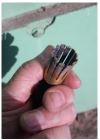Fixing a 3CX3000A7 Socket Problem

[February 2019] Although the number of tube transmitters is dropping, troubleshooting skills are still needed when problems turn up.
There is a common failing in the tube type 3 kW to 10 kW transmitters.
The problem is that the center filament contact of the 3CX3000A7 tube socket is rather small and tends to get crusty and then the output goes away.
Pulling the tube out and replacing it will bring things back for a while but then one day soon it will fall off again. The tube itself may well be fine but a cold filament just will not cut it!
A Crusty Mess
This socket came from an Energy-Onix ECO-4 transmitter.

Since similar tube sockets I had previously stumbled on were already damaged I have to admit I have never actually watched a filament connection corrode.
My best guess is that as the socket pin is rather small and carries about 75 Amps of 60 Hz current – and nearly half an Amp of 100 MHz RF in the grounded-grid amplifier – just the smallest bit of dust or an off-centered location of the tube in the socket would cause arcing.
Over time, the arc marks would just get worse and worse until you get what the picture shows.
In fact, the whole connection gets worse as the metal heats up and then loses its springiness (tension). The result is that even after you clean and burnish the surface, the next tube cannot break through the crusty surface making it harder to achieve a good, clean connection.
Check the Tube Too
 Cleaning up the surface of the socket and then reinstalling it brought everything back to normal.
Cleaning up the surface of the socket and then reinstalling it brought everything back to normal.
By the way, you will notice the three high-temperature rubber O rings that we added around the outside of the socket to increase the tension on the connection.
(I have also used clip rings to tighten the grip of the socket on the tube center filament pin.)
Do carry a mirror with you, though, it is hard to get into a position where you can look down into the socket – using a mirror will certainly be helpful.
Furthermore, while you are working on the socket, it is a good idea to take the time to check the bottom of the tube and clean it up as well.
Similarly, when you change tubes, take a look at the base of the tube you pull out. If the tube base center pin shows arc marks or is not clean and smooth then the socket is almost sure to be corroded.
Bottom line: do not throw away a usable transmitter over a single bad connection!
– – –
Timothy Cutforth is the President of Vir James Associates, engineering consultants in Denver, and the owner of KCEG and KJME in Fountain, Colorado. Contact him at: tcut4th@msn.com
